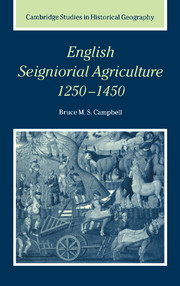Book contents
- Frontmatter
- Contents
- List of figures
- List of tables
- Preface and acknowledgements
- Abbreviations
- Weights, measures, values, and boundaries
- 1 Introduction: agriculture and the late-medieval English economy
- 2 Sources, databases, and typologies
- 3 The scale and composition of the seigniorial sector
- 4 Seigniorial pastoral production
- 5 Seigniorial arable production
- 6 Crop specialisation and cropping systems
- 7 Arable productivity
- 8 Grain output and population: a conundrum
- 9 Adapting to change: English seigniorial agriculture 1250–1450
- Appendix 1 Demesne-level classification of husbandry types
- Appendix 2 Demesnes represented in the Norfolk accounts database
- Appendix 3 Demesnes represented in the FTC accounts databases
- Consolidated bibliography
- Index
- Cambridge Studies in Historical Geography
3 - The scale and composition of the seigniorial sector
Published online by Cambridge University Press: 20 October 2009
- Frontmatter
- Contents
- List of figures
- List of tables
- Preface and acknowledgements
- Abbreviations
- Weights, measures, values, and boundaries
- 1 Introduction: agriculture and the late-medieval English economy
- 2 Sources, databases, and typologies
- 3 The scale and composition of the seigniorial sector
- 4 Seigniorial pastoral production
- 5 Seigniorial arable production
- 6 Crop specialisation and cropping systems
- 7 Arable productivity
- 8 Grain output and population: a conundrum
- 9 Adapting to change: English seigniorial agriculture 1250–1450
- Appendix 1 Demesne-level classification of husbandry types
- Appendix 2 Demesnes represented in the Norfolk accounts database
- Appendix 3 Demesnes represented in the FTC accounts databases
- Consolidated bibliography
- Index
- Cambridge Studies in Historical Geography
Summary
The seigniorial share of agricultural output and land-use
Lords differed from other agricultural producers in the scale and relative factor endowments of their respective production units. The feudal system ensured that lords generally enjoyed privileged access to land, coercive powers over labour and often a superior command over capital. Lords held their land on more generous terms than other producers, especially unfree tenants, and their individual demesne farms were commonly operated as components of federated estates. The greatest of these estates comprised dozens of individual demesnes, thousands of acres of land, and encompassed a wide range of agricultural environments. As ‘firms’ many were therefore both horizontally and vertically integrated and consequently enjoyed significant scale economies. Concomitant management structures, especially on the greatest and most farflung estates, could nevertheless be excessively bureaucratic, to the detriment of both efficiency and enterprise. Low work motivation and high policing costs also went hand in hand with a traditional reliance upon forced servile labour. That was why the more enlightened and progressive lords increasingly commuted labour services and substituted hired labour, both permanent and casual. The latter was nevertheless inferior in motivation, application and enterprise to the family labour employed on most peasant holdings.
Lords produced both for consumption and exchange. They used their estates to provision their households and to generate a cash income from the sale of surplus produce, of which there could be a great deal since the scale of many demesnes and estates was more than equal to the consumption requirements of the seigniorial households which they were intended to support.
- Type
- Chapter
- Information
- English Seigniorial Agriculture, 1250–1450 , pp. 55 - 101Publisher: Cambridge University PressPrint publication year: 2000

